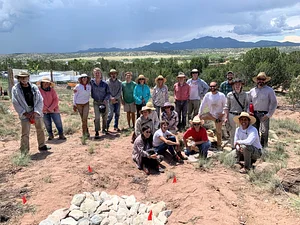
Hacienda Dominguez & Chelenzo Farms
Short description of your place and practices
ABOUT CHELENZO FARMS
Founded upon a dream of a healthier life closer to nature, Chelsea & Lorenzo (Chelenzo) moved to New Mexico from New York in 2021 with their family to plant regenerative roots in the Land of Enchantment.
Chelenzo Farms is a work-in-progress and will offer visitors the opportunity to tour and experience an homestead in action. Applying permaculture, organic farming and land conservation principles, the Dominguez Family & Team aspire to rejuvenate the magical landscape into a flourishing rain garden and small scale farm replete with edible native plants and trees.
Set in high desert mountains of Cerrillos, New Mexico, Hacienda Domínguez & Chelenzo Farms offers guests the opportunity to hike daily on 350 acres just east of the Turquoise Trail (Route 14) and directly above the Galisteo River Basin. Upon the land, nature lovers, hikers and outdoorsmen alike will discover arroyos, caves, mesmerizing 360 degree vistas of the mountains that surround Santa Fe, as well as awe-inspiring sunrises and sunsets.
At Chelenzo Farms we apply permaculture, soil health, agroecology and agroforestry principles and are enthusiastic about applying innovative, indigenous and regenerative practices to achieve our goals.
Our organic research farm serves to educate the community, resolve food insecurity issues and offer training in permaculture farming, land conservation, indigenous agricultural and sustainability practices, and the realm of sciences that look to understand the relationship (past, current and future) that humans have with nature and the land. We also aspire to contribute to knowledge about agricultural practices that contribute to improved soil health in an arid environment, amidst a multi-year megadrought.
For more information check out our website at www.chelenzofarms.com
A FEW OF OUR OBJECTIVES
Address food insecurity and agrobiodiversity to enhance resilience and broaden American food diets by optimizing land management and sustainable production systems with the reintroduction of traditional indigenous and campesino crops native to AridAmerica.
Conversion of one acre at Waterfall Meadow on Hacienda Dominguez & Chelenzo Farms (Cerrillos, NM) into a permaculture food forest with CAM succulents & native plants found in the Galisteo Basin of New Mexico. This initiative will serve as an experimental model and provide baseline data for expansion of ecosystem restoration on 350 acres, which will be supported by a future ecosystem restoration camp in the neighboring one-acre field.
Employ indigenous-inspired and water harvesting structures including one-rock dams, Zuni bowls, zaja y bordo (Mexican ditch and berm terraces to support agave) and keyline structures to promote the understanding and use of irrigation-less agriculture, especially among producers in the American Southwest, which has experienced a multi-decade doubt and will likely continue to considering climate change forecasts.
Working with our technical adviser, Dr. Sangu Angadi, implement Semi-Circular Buffer Strips. Using a media luna (half circle) approach we will use this form of crop planning to mitigate soil erosion, harness water, and serve as a wind buffer (wind combines with precipitation, being the primary cause of soil erosion in the high mountain desert). We will not be using irrigation and solely depending on water harnessed by rain, snowmelt and the significant condensation that we experience in fall and winter in Northern New Mexico when temperatures warm up 30 to 40 degrees on a daily basis.
Contribute to the knowledge in specialty crop research focused on drought-resistant crops and desert plants, including ten CAM succulents and native plants highlighted by Gary Paul Nabhan, Patricia Colunga-GarcíaMarín and Daniel Zizumbo-Villarreal in the June 2022 paper “Comparing Wild and Cultivated Food Plant Richness Between the Arid American and the Mesoamerican Centers of Diversity, as Means to Advance Indigenous Food Sovereignty in the Face of Climate Change.”
Promote awareness about the importance of using native seed and seedlings for ecological system restoration and increase availability of native seed and seedlings for habitat restoration and conservation by establishing a seed bank via a partnership of the Institute for Applied Ecology’s Southwest Seed Partnership Program and the development of a starts nursery in our 33’ geodesic grow dome.
Mitigate soil erosion, restore soil health and our local ecosystem, as well as regrow our plant and animal pollinator population.
Establish and supply existing pipeline for indigenous/ethnic food markets and nurseries for CAM succulent products, especially those serving clients seeking ecological restorative vegetation, which is experiencing a supply shortage.
Mitigate local pollution caused by carbon monoxide and dust that blows over from the neighboring motocross track by planting Honey Locust trees and shrubs as a windbreak. Parallel to the project meadow is a large berm that was likely created by the Army Corps of Engineers to mitigate flooding from an arroyo that runs perpendicular to the berm to the Santa Fe Railroad line that runs through the Galisteo Basin along the Galisteo River.
